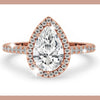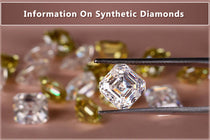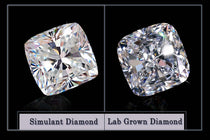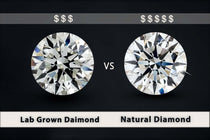Simulated diamonds, also known as diamond simulants, have grown in popularity as an affordable and ethical alternative to natural diamonds.
These stones mimic the appearance of natural diamonds but possess different physical and optical properties.
Diamond simulants can be created from various materials, such as cubic zirconia and moissanite, and are often favored by those looking for a more budget-friendly option without sacrificing beauty or style.
Table Of Contents
- Understanding Simulated Diamonds
- Types of Diamond Simulants
- Comparing Physical Properties
- Optical Characteristics
- Difference Between Simulants and Synthetic Diamonds
- Natural Diamonds vs Simulants
- Selecting a Diamond Simulant for Jewelry
- Evaluating Quality and Performance
- Conclusion
- Frequently Asked Questions
Understanding the key differences between simulated diamonds and their natural counterparts is essential for making an informed decision when selecting a stone for jewelry.
While simulants may look very similar to natural diamonds at first glance, there are subtle differences in their physical properties, optical characteristics, and overall quality.
Moreover, it is important to distinguish between diamond simulants and synthetic diamonds, which are lab-created diamonds with the same properties as natural diamonds, but grown using artificial methods.
Key Takeaways
- Simulated diamonds are an affordable, ethical alternative that mimics the appearance of natural diamonds but with different physical and optical properties.
- Diamond simulants can be made from various materials, with cubic zirconia and moissanite being popular choices.
- A clear understanding of the differences between diamond simulants, synthetic diamonds, and natural diamonds can help in making informed decisions when selecting a stone for jewelry.
Understanding Simulated Diamonds
Simulated diamonds, also known as diamond simulants, are man-made gemstones that closely resemble the appearance of natural diamonds. These stones are designed to mimic the physical and optical properties of diamonds, but they have a different chemical composition.
One significant difference between simulated diamonds and natural diamonds is the way they are formed.
Natural diamonds are created deep within the Earth's mantle under extreme heat and pressure over the course of millions of years. On the other hand, simulated diamonds are created in laboratories using various chemical and physical processes.

Among the various types of diamond simulants, the most popular ones include cubic zirconia (CZ) and moissanite. CZ is made from zirconium dioxide, a crystalline material known for its durability and diamond-like appearance.
Moissanite, another popular diamond simulant, is composed of silicon carbide and has a slightly different refractive index and visual appeal when compared to diamonds.
While simulated diamonds may look like natural diamonds, their value is significantly lower due to their artificial origins. Additionally, experts can typically identify the differences between the two through specific visual, chemical, and physical tests.
It's worth noting that lab-grown diamonds, also known as lab-created diamonds, are distinct from diamond simulants. Lab-grown diamonds have the same chemical and physical properties as natural diamonds, while simulants do not. This distinction is crucial for understanding their value and market demand.
In summary, simulated diamonds offer an affordable alternative to natural diamonds for those seeking the aesthetic appeal and brilliance of diamonds without their high price tag. However, it's essential to recognize the differences between diamond simulants, lab-grown diamonds, and natural diamonds when making a decision about the right gemstone for your needs.
Types of Diamond Simulants
Diamond simulants are man-made materials that replicate the appearance and properties of natural diamonds. They offer an affordable alternative to expensive diamonds for use in jewelry and various industrial applications. When comparing simulants, it is essential to look at their hardness, fire, brilliance, and durability.
One popular diamond simulant is cubic zirconia, which is composed of zirconium dioxide. Cubic zirconia has high refractive index and impressive dispersion, closely resembling diamonds. However, it is somewhat softer and less durable than diamonds, making it less suitable for everyday wear.
Another well-known simulant is moissanite. Created from silicon carbide, moissanite boasts a high refractive index and exceptional fire compared to other diamond simulants. Growths in the popularity of moissanite can be attributed to its durability, making it perfect for use in jewelry and industrial applications.

White sapphire is a natural gemstone used as a diamond simulant. With a sturdy composition, white sapphire is hard and resists scratching. Although its fire and brilliance are moderate compared to diamonds, it remains a popular choice for those seeking an affordable alternative.
Similarly, white zircon and white topaz are natural gemstones often used as diamond simulants. While white zircon resembles diamonds' fire, its low hardness makes it more susceptible to damage. On the other hand, white topaz withstands abrasions well but has limited fire and brilliance compared to diamonds.
Gadolinium gallium garnet was once a popular diamond simulant for its similar appearance and properties to diamonds. Owing to its rareness and costly production, this simulant has decreased in popularity.
Structured materials such as film, glass, and strontium titanate are less common diamond simulants. Film is an affordable option used to cover imperfections on real diamonds, while glass can be cut to imitate diamonds but lacks durability and transparency. Lastly, strontium titanate exhibits impressive fire but has a low hardness, making it prone to scratches and damage.
By understanding the properties and characteristics of each diamond simulant, one can make an informed decision when choosing the perfect material for their needs.
Comparing Physical Properties
Simulated diamonds, also known as synthetic or lab-grown diamonds, have gained popularity due to their ethical and environmental advantages. In this section, we will compare the physical properties of simulated diamonds with those of natural diamonds, focusing on hardness, durability, and color.
Hardness refers to a material's resistance to scratches and abrasions. On the Mohs scale, natural diamonds are ranked as the hardest known material with a score of 10. Simulated diamonds, grown using techniques such as Chemical Vapor Deposition (CVD) or High-Pressure High-Temperature (HPHT), also rank at a 10 on the Mohs scale. They possess similar hardness as natural diamonds, allowing them to resist scratches and maintain their polished appearance.
0.81 CT Round Diamond Ring, EF/VS Lab Grown Diamond Engagement Ring
Durability is another important factor to consider when comparing natural and simulated diamonds. Durability refers to the ability of a material to withstand wear, pressure, or damage. Both natural and simulated diamonds share the same crystal structure, which contributes greatly to their durability. However, CVD- and HPHT-grown diamonds may have varying degrees of stability, depending on the specific growth process and the incorporation of inclusions or defects. In general, though, simulated diamonds are considered to be highly durable and suitable for everyday wear.
Finally, color is a critical aspect of evaluating diamonds. While some natural diamonds exhibit colors due to the presence of impurities, many are valued for their colorlessness. Simulated diamonds can be grown to achieve a high degree of colorlessness, often achieving better color grades than some natural diamonds. Techniques like CVD and HPHT can precisely control the growth environment, allowing the production of colorless diamonds without the presence of trace elements that may affect the color.
In summary, simulated diamonds showcase comparable physical properties to natural diamonds in terms of hardness, durability, and color. The advancements in lab-grown diamond technology continue to improve, making them a more sustainable and ethical choice for consumers.
Optical Characteristics
Simulated diamonds, often known as lab-created or synthetic diamonds, exhibit remarkable optical characteristics that closely mimic those of natural diamonds. Due to their similarities in color, sparkle, fire, and overall appearance, they are a popular alternative for various uses including jewelry and industrial applications.
The color of simulated diamonds can range from colorless to near-colorless shades, much like their natural counterparts. High-quality synthetic diamonds are carefully grown to minimize color impurities, resulting in a stunning appearance comparable to high-grade natural diamonds.
Sparkle is an essential aspect of a diamond's allure and is a direct result of a diamond's refractive index. Simulated diamonds have a similar refractive index to natural diamonds, which allows them to exhibit a comparable sparkle. This trait is particularly important when it comes to jewelry, as the sparkle enhances their overall beauty and appeal.

Another aspect of optical properties in diamonds is the fire, which is the dispersion of light into various colors. Simulated diamonds display an impressive fire, thanks to precise manufacturing processes that replicate the internal structure of a natural diamond. This structure ensures a high level of light dispersion, giving synthetic diamonds their fiery characteristic.
The overall appearance of a simulated diamond is virtually indistinguishable from that of a natural diamond, especially to the untrained eye. Advanced manufacturing processes, such as Chemical Vapor Deposition (CVD) and High-Pressure High-Temperature (HPHT) methods, imitate the conditions under which natural diamonds form. This results in synthetic diamonds that exhibit similar visual characteristics, including clarity and cut.
In conclusion, the optical properties of simulated diamonds are remarkably similar to those of natural diamonds. With advancements in production techniques, synthetic diamonds are becoming increasingly indistinguishable from their natural counterparts, making them an attractive and affordable option for various applications.
Difference Between Simulants and Synthetic Diamonds
Simulants and synthetic diamonds are two different types of diamond alternatives that are commonly found in the jewelry market. While both serve as alternatives to natural diamonds, they have distinct properties and characteristics.
A simulated diamond is a stone that has a similar appearance to a diamond, but its chemical composition and physical properties are different. These stones are usually made from materials such as cubic zirconia or moissanite, and they offer a more affordable option for jewelry enthusiasts. However, their appearance may be less brilliant and their durability is generally lower compared to natural or synthetic diamonds.
On the other hand, a synthetic diamond is also known as a lab-grown or lab-created diamond. These stones are made using advanced technologies such as Chemical Vapor Deposition (CVD) and High-Pressure High Temperature (HPHT) methods. Synthetic diamonds have the same chemical composition and crystal structure as natural diamonds, making their appearance and physical properties virtually identical.

Lab-grown diamonds offer several advantages over natural diamonds as well as simulants. They are ethically sourced, as they do not involve mining activities that can harm the environment or exploit workers. Additionally, synthetic diamonds are generally less expensive than their natural counterparts while maintaining the same level of beauty and durability.
It is essential for buyers to understand the differences between simulated and synthetic diamonds because the quality, durability, and value of these alternatives vary significantly. Simulated diamonds may be a more cost-effective choice but will not exhibit the same sparkle and longevity as a true diamond. In contrast, lab-created diamonds provide a nearly identical appearance and durability to natural diamonds without the ethical and environmental concerns associated with mining.
By being well-informed about the distinctions between simulants and synthetic diamonds, customers can make knowledgeable decisions when purchasing diamond alternatives for their jewelry collections. Remember that both options offer unique benefits and drawbacks, so it ultimately comes down to personal preferences and priorities.
Natural Diamonds vs Simulants
Natural diamonds, also known as mined diamonds, are formed deep within the Earth's mantle over millions of years. They are formed through intense heat and pressure that cause carbon atoms to crystallize, creating the unique structure and brilliance we associate with diamonds. These diamonds are then brought to the surface through volcanic eruptions and mined from the Earth. Natural diamonds are not only admired for their beauty but also for their exceptional properties such as hardness, thermal conductivity, and refractive index.
Simulants, on the other hand, are materials that resemble natural diamonds but have different chemical compositions and physical properties. They can be either artificially created or naturally occurring minerals that imitate the appearance of a diamond, but they are not true diamonds. Some common diamond simulants include cubic zirconia (CZ), moissanite, and synthetic white sapphire. It is essential to note that simulants are not considered synthetic diamonds, as they have different chemical compositions from natural diamonds.

One significant difference between natural diamonds and simulants is their price. Natural diamonds tend to be more expensive due to their rarity and the costs involved in mining and processing them. Simulants, however, can be mass-produced at a lower cost, making them more affordable for consumers. This price difference can be appealing to those looking for the diamond's visual appeal without breaking the bank.
Another key difference is the durability and hardness of the two. Natural diamonds are renowned for being the hardest known material, ranking 10 on the Mohs scale of mineral hardness. This makes them highly resistant to scratches and wear, adding to their long-lasting appeal. In contrast, diamond simulants have lower hardness ratings, with cubic zirconia at 8-8.5 and moissanite at 9.25 on the Mohs scale. This means that simulants are more prone to scratches and damage compared to natural diamonds.
Optical properties also vary between natural diamonds and simulants. Diamonds exhibit a high refractive index, giving them exceptional brilliance, dispersion, and scintillation. While some simulants, such as moissanite, come close to replicating these optical properties, they often display slightly different characteristics that distinguish them from natural diamonds. For example, moissanite tends to exhibit a higher degree of dispersion, sometimes known as the "rainbow effect," which results in more colorful flashes as light passes through the gemstone.
In summary, the primary differences between natural diamonds and simulants lie in their composition, price, durability, and optical properties. When considering a diamond or a diamond simulant, it is crucial to understand these differences and tailor the choice according to personal preferences and budget.
Selecting a Diamond Simulant for Jewelry
When considering a diamond simulant for jewelry, there are several factors to take into account. Diamond simulants, or imitation diamonds, offer a more affordable yet visually striking alternative for various types of jewelry, including engagement rings, diamond engagement rings, and diamond jewelry.
One popular diamond simulant is moissanite. It is well-regarded for its brilliance, fire, and luster, which closely resemble that of a natural diamond. There are several cuts available for moissanite, such as the Round Brilliant Cut Moissanite, Cushion Cut Moissanite, and Princess Cut Moissanite, each offering its unique appeal and style.

When choosing a diamond simulant, consider the intended purpose and style of the jewelry. For instance, a cushion cut moissanite engagement ring may be ideal for someone seeking a vintage-inspired look, while a modern design may call for the classic Round Brilliant Cut moissanite.
It is also essential to consider the quality and craftsmanship of the jewelry setting. A well-crafted setting will not only enhance the beauty of the diamond simulant but also ensure your jewelry will last for years to come.
Lastly, when selecting a diamond simulant for jewelry, consider the various options for wedding bands that complement the chosen engagement ring. A helpful style guide can assist in determining the perfect match, enhancing the overall aesthetic of your wedding set.
By taking these factors into account, you can confidently select a diamond simulant for jewelry that suits your personal style, budget, and desired look.
Evaluating Quality and Performance
When it comes to evaluating the quality and performance of simulated diamonds, it's essential to seek the expertise of professional gemologists. These experts can accurately assess various characteristics, such as clarity, cut, and carat weight, among others.
One critical aspect to consider is the hardness of a diamond, which can be determined using the Mohs scale of hardness. Diamonds are known for their exceptional hardness, ranking 10 on the scale, making them highly resistant to scratches and abrasions. This also contributes to their longevity and overall performance, especially in solitaire engagement rings.

Additionally, it is valuable to compare simulated diamonds to other gemstones, such as sapphires, to better understand their unique properties and uses. Sapphires are another popular choice for jewelry and typically rank 9 on the Mohs scale of hardness, making them slightly softer than diamonds but still durable enough for various applications.
An important factor in the performance of simulated diamonds is their ability to withstand regular wear and tear. Proper care and maintenance play a significant role in preserving the beauty and longevity of your diamond jewelry.
In conclusion, evaluating the quality and performance of simulated diamonds involves the expertise of gemologists, understanding the importance of hardness on the Mohs scale, and comparing them with other popular gemstones like sapphires. Regular care and maintenance also contribute to the durability and long-lasting beauty of these precious stones.
Conclusion
Simulated diamonds, also known as diamond alternatives, offer a sustainable and budget-friendly option for those looking to purchase a beautiful and durable gemstone without the high cost of natural diamonds. These stones are created through various processes, including lab-grown methods and simulant production.
Lab-grown diamonds are chemically and structurally identical to natural diamonds, making them an excellent choice for those who want a sustainable, environmentally-friendly, and ethically-sourced gemstone. They are grown in controlled environments, which significantly reduces their impact on the environment when compared to the resource-intensive mining of natural diamonds.
2.01 CT Cushion Cut Lab Grown Diamond, F/VS Loose Lab Diamond for Ring
Diamond simulants, such as cubic zirconia and moissanite, provide a more budget-friendly option for those who still desire the look of a diamond without the high price tag. These stones mimic the appearance of a natural diamond but have a different chemical composition and crystal structure. Although they may not be as durable as natural or lab-grown diamonds, they are still an attractive option for those on a budget and looking for a beautiful, sparkling gemstone.
In summary, simulated diamonds offer various benefits, including sustainability, affordability, and ethical sourcing. They provide an excellent choice for individuals who want a beautiful gemstone without the environmental and financial concerns associated with natural diamonds. With the increasing advancements in technology, simulated diamonds continue to gain popularity among consumers, offering a wide range of options for those looking for the perfect gemstone to suit their style and budget.
Frequently Asked Questions
How do simulated diamonds compare to real diamonds?
Simulated diamonds, also known as diamond simulants, are man-made materials that have the appearance of natural diamonds but are different chemically and physically. While they may look similar to real diamonds, they do not possess the same durability, brilliance, or rarity as natural diamonds. Factors such as hardness, refractive index, and dispersion are different in simulated diamonds compared to natural ones.
What are the differences between simulated diamonds and moissanite?
Both simulated diamonds and moissanite are man-made materials that resemble diamonds. The primary difference between the two lies in their chemical composition. Simulated diamonds can be made of various materials such as cubic zirconia or synthetic rutile, whereas moissanite is composed of silicon carbide. Moissanite has a higher refractive index than most simulated diamonds, giving it more fire and brilliance. However, it also has a higher dispersion rate, which can make it appear more colorful and somewhat less diamond-like.
How is the quality of simulated diamonds?
The quality of simulated diamonds varies depending on the material used and the manufacturing process. High-quality simulants like cubic zirconia can possess excellent clarity, cut, and polish, closely resembling the appearance of natural diamonds. However, they may not have the same durability or hardness as natural diamonds, making them more prone to scratches and damages.
How do simulated diamonds and cubic zirconia differ?
Cubic zirconia is a type of simulated diamond, but not all simulated diamonds are cubic zirconia. Simulated diamonds can be made from various materials, while cubic zirconia is specifically made from zirconium dioxide. Cubic zirconia is one of the most popular and widely used diamond simulants due to its affordability, availability, and close resemblance to natural diamonds in terms of appearance.
What is the value of simulated diamonds?
The value of simulated diamonds is significantly lower than that of natural diamonds. This is primarily due to the lack of rarity, as well as differences in physical and chemical properties. However, simulated diamonds can still be an affordable and attractive option for those seeking a diamond-like appearance without the higher price tag of natural diamonds.
Do VVS simulated diamonds pass a diamond tester?
VVS (Very Very Slightly Included) refers to the clarity grade of a diamond, indicating that it has minimal inclusions. While a VVS simulated diamond may closely resemble a natural VVS diamond visually, it will not pass a diamond tester. Diamond testers work by measuring the heat conductivity of a gemstone. Since simulated diamonds have different thermal properties than natural diamonds, they will show up as non-diamond on a tester.
Checkout some of our top collections:









